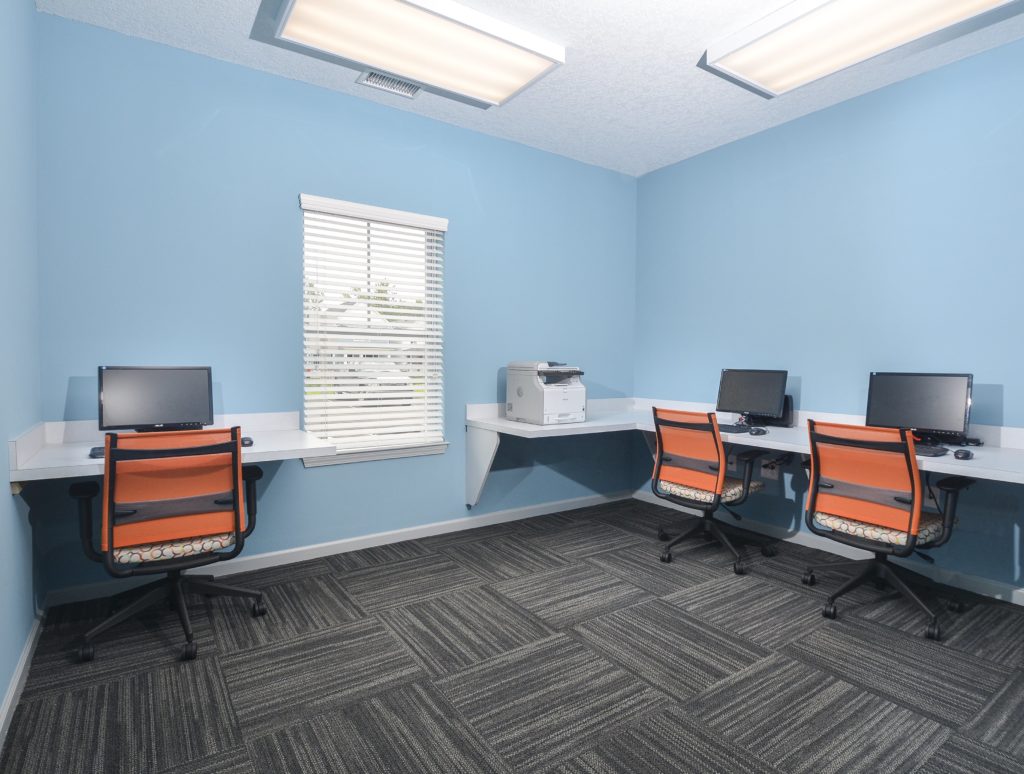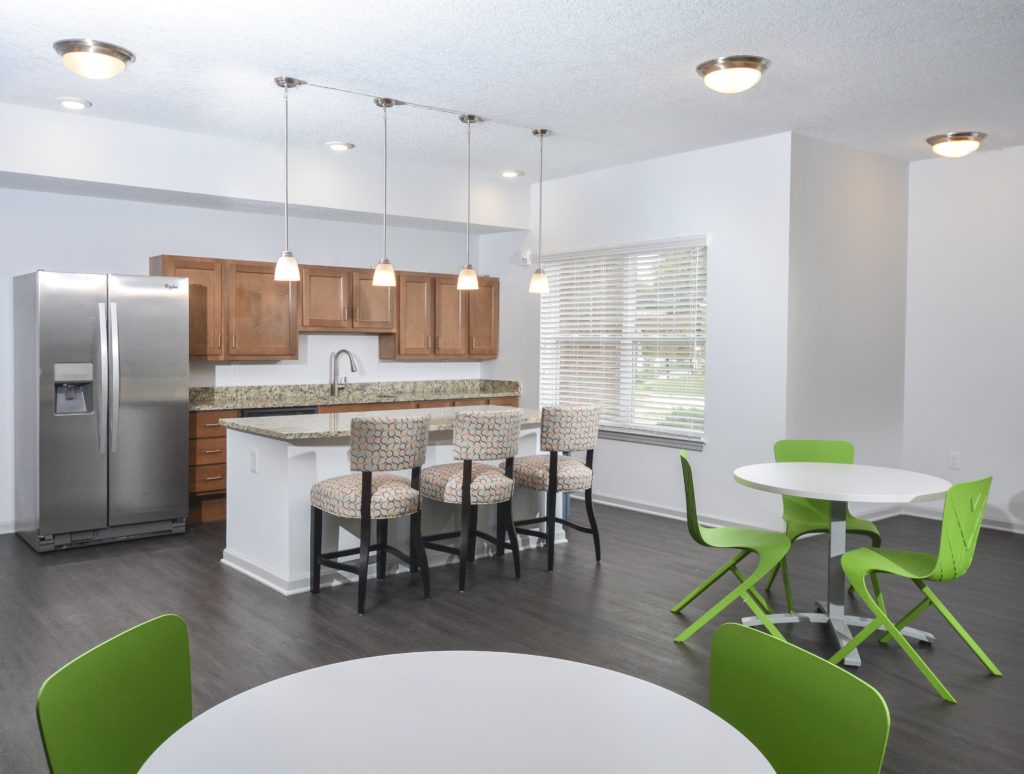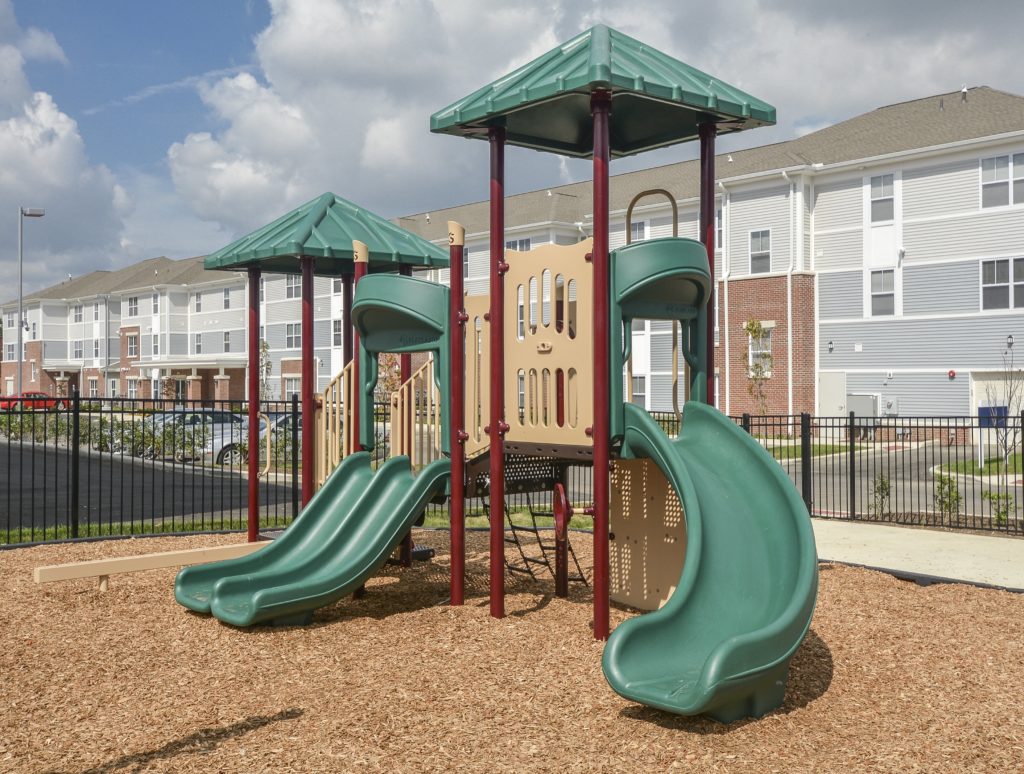The Residences at Career Gateway is a community housing development, funded with the help of Low Income Housing Tax Credits (LIHTCs) [1], which aims to revitalize the south side of Columbus and connect residents with meaningful workforce supports. The Residences is an urban infill project on the site of a vacant elementary school building and offers a total of 58 units, split between 1- and 2-bedroom apartments and 3-bedroom townhomes.
Workforce training and career development are emphasized through a 2,400-sf innovative workforce training room, where community partners host specialized workshops for all members of the Gateway. Similarly, the project has partnered with local entities such as Nationwide Children’s Hospital to create a link to area employment.

Syndicated through the Ohio Housing Finance Agency (OHFA), the project was awarded $1 million in LIHTC over 10 years. In Ohio, developers can apply for either a competitive (9 percent) credit or a non-competitive (4 percent) credit. Residences at Career Gateway was awarded a competitive credit. The developer, NRP Holdings LLC, also utilized a $1.5 million Housing Development Loan for the project. The Housing Development Loan program is funded through the Ohio Department of Commerce and provides short-term, low-interest loans to developers that have been awarded the competitive LIHTC credit or bond gap financing.
Overview
| Location | The Residences at Career Gateway 755 E. Whittier Street Columbus, OH 43206 |
| Project Type | Affordable (at or below 60% AMI) |
| Development Partners | NRP Holdings, LLC Community Development for All People NRP Career Gateway Homes, LLC CD4AP Career Gateway Homes, LLC |
| Site Size | Roughly 3 acres |
| Housing Types | A three-story apartment building with 44 homes and 14, three-story townhomes with attached garages |
| Unit Costs | Pricing for the apartments starts at $650 per month, with all units reserved for households at or below 60 percent of the area median income. |
| Development Costs | $11,924,026 |
| Funding Sources (Owner Cost Certification) | Ohio Equity Fund Nationwide IV: $9,755,024 in housing credit equity RiverHills Bank: $1,375,000 primary hard loan City of Columbus: $250,000 primary soft loan NRP Holding, CD4AP: $169,002 deferred developer fee CD4AP Career Corp.: $375,000 general partner equity |
| Development Timeline | September 2015: LIHTC final application submitted to OHFA January 2016: Project approved by OHFA September 2017: Project construction completed April 2018: Form 8609 (United States Low-Income Housing Credit Allocation and Certification Form) submitted signifying the project is complete |
| Website | https://www.residencesatcareergateway.com/ |
Background on the South Side of Columbus
Prior to construction, the south side of Columbus was one of the worst neighborhoods for economic quality of life relative to the entire city. In 2010, median income of households in the southside was 43 percent lower than Franklin County as a whole ($27,943.63 and $49,087, respectively). The percent of people with a high school diploma or higher was also greater in Franklin County at a rate of 88.9 percent, compared to 74.9 percent in the south side.
2010 Indicators(Census tracts used include: 53, 54.10, 54.20, 55, 56.10, 56.20, 59, 87.10.)
| Unemployment rate: | 23.9% |
| Median household income: | $27,943.60 |
| Labor force participation rate: | 60.7% |
| High school graduate or higher: | 74.9% |
Employment indicators were similarly worse for the south side, compared to Franklin County. Seventy percent of those over the age of 16 were in the labor force for Franklin County; the rate was 60.1 percent for the south side. Perhaps most indicative of the local disinvestment and lack of employment opportunities, the south side had an unemployment rate of 23.9 percent, compared to 8 percent for Franklin County.
Since 2010, the south side of Columbus has been undergoing substantial transition. In 2016, changes in the south side were spurred, in part by a massive $730 million, 11-project expansion at Nationwide Children’s Hospital that will add 2,000 jobs to the city by 2024. Beyond the thousands of employment opportunities available at the hospital, Columbus State Community College also offers workforce training for in-demand occupation to residents of Career Gateway.
The development team at NRP Holdings LLC created a strategic partnership with Nationwide Children’s as a part of the hospital’s Healthy Neighborhoods Healthy Families (HNHF) initiative. The initiative, which began in 2008, has key impact areas, including providing affordable housing and workforce development for local residents—both achieved through the Residences project.
Healthy Homes is the title of the affordable housing initiative of HNHF. Since 2008, the program has renovated 117 homes, provided 166 home improvement grants and built 31 new homes. A total of 350 homes have been impacted by Healthy Homes, with partner nonprofits investing a total of $30,194,700 into the south side neighborhood.
2017 Indicators
| Unemployment rate: | 17.2% |
| Median household income: | $30,016.80 |
| Labor force participation rate: | 66.6% |
| High school graduate or higher: | 79.9% |
Since 2010, the south side of Columbus has modestly improved in all quality of life indicators. Residence at Career Gateway positively contributed toward these changes by provide stable housing and promoting employment.
Impact
Tenant Profile (2017)
| 97 tenants |
| Average age: 28.8 |
| Average income: $7,604.98 |
| Average total income per household: $19,946.30 |
| 27 full-time students, 69 non-students, 1 part-time student |
| 62 black or African American, 8 white, 4 other, 23 not disclosed |
| 62 female, 32 male, 3 N/A |
| 55 receiving federal income assistance, 42 not receiving |
Design and Lessons Learned
The design behind Residences at Career Gateway was guided with the goal of creating a pathway from poverty to opportunity, while maintaining the socio-economic diversity of the community. This was done by providing housing that incorporates workforce training leading to employment, further supported by building a bridge between the community and the area’s largest employer in Nationwide Children’s. OHFA’s decision to distribute the LIHTC credits with a focus on workforce development coincided with Nationwide’s desire to create an employee base in neighborhood and furthered this effort.
The success of the Residences at Career Gateway can be tied to a complete buy-in from the partners involved with the project, as well as the recognition of the connection between housing and health care. From the top down, those at Nationwide Children’s recognized that proactively treating the community through stable housing and employment is a financially efficient health care strategy. Those who fill the role as major employers and economic engines of communities, such as hospitals, as well as those on the policy side of housing and healthcare, are beginning to understand how community investment can be a financially sustainable and benevolent decision.
Any project that involves urban infill – taking an existing landscape and changing it – will be a large task to undertake. Those at NRP Group, including Senior Vice President of Development Aaron Pechota, noted that when you layer a zoning process, a demolition in a dense neighborhood, and a coordinated effort to fit into the neighborhood, development can become complicated. Due to the relative lack of development in the south side, the project gained neighborhood support, as the community was happy to see any development.
The work Nationwide Children’s and its partnered nonprofit, Community Development for All People, had been doing in the community led to a desire to provide more than just housing; any new development would need to balance creating more affordable housing with additional services. For Residences, the housing was the foundation, but the workforce training center stretched the project financing to a greater value.
The location has provided opportunity for beneficial housing to be in walking distance to employment. Career Gateway provides secure housing intended as a starting point and model for health and safety to revitalize the south side, which has suffered from loss of industry and employment opportunities over the years. A focus on social determinants, primarily for children, provides justification for the housing design. Those involved see the applicability of Career Gateway’s design for cities across the United States.
[1] The LIHTC program was created in 1986 and remains as the United States federal government’s primary program for promoting and financing affordable housing throughout the country. The main feature of the program is provided tax credits to encourage individual and corporate investors to invest in the development, acquisition, and rehabilitation of affordable rental housing. The Internal Revenue Service allocates federal tax credit to state housing credit agencies; OHFA is Ohio’s authorized agency. Each year, state agencies release documents outlining their criteria for awarding credits to projects. The developers whose projects have been awarded generally sell their credits to private investors for additional funding. Once a housing project is complete (made available to tenants), investors can claim the LIHTC for a 10-year period.








